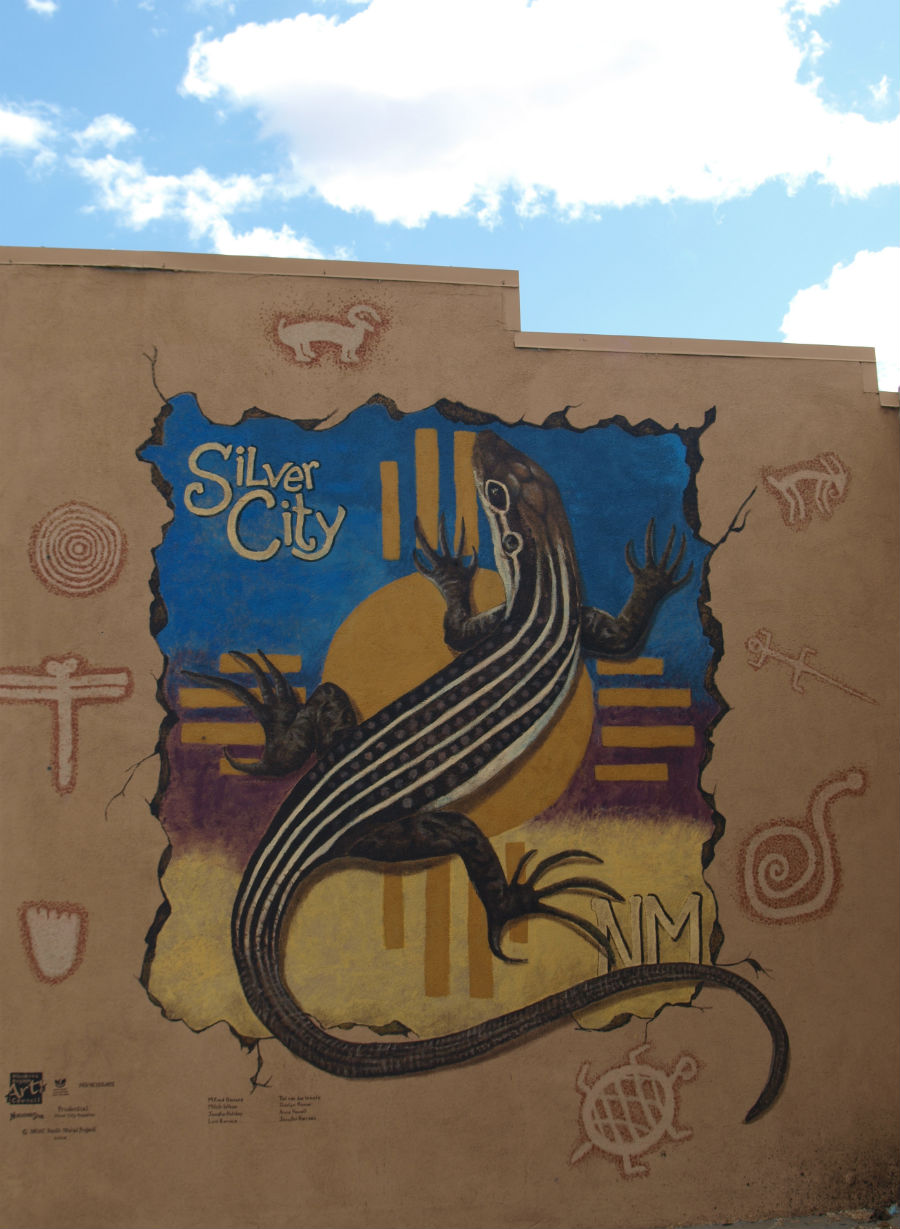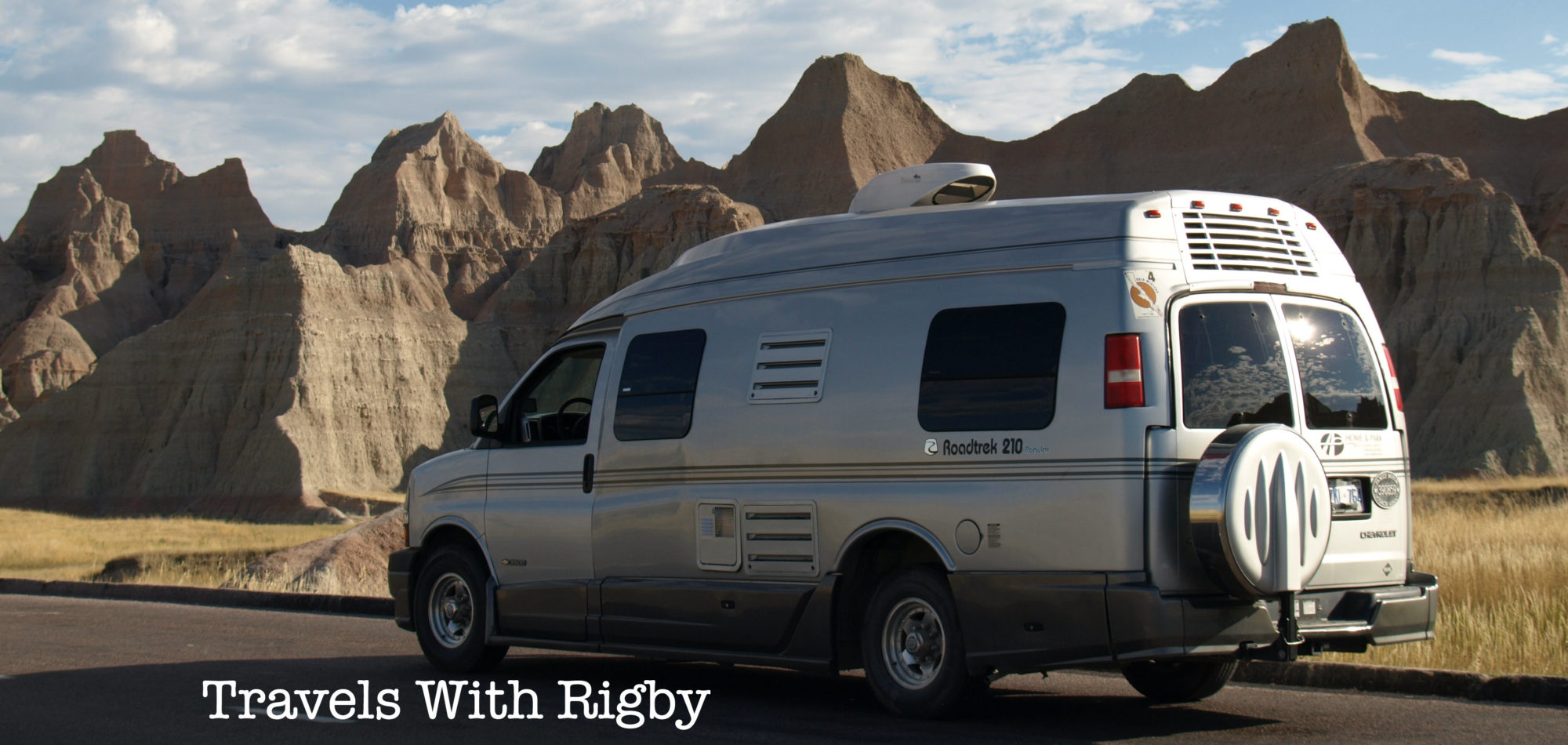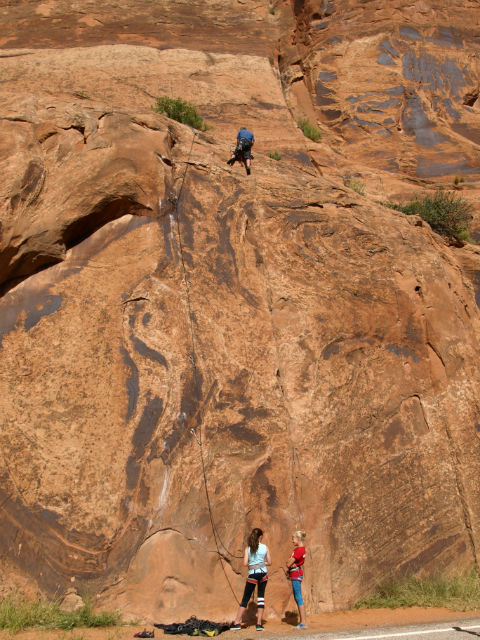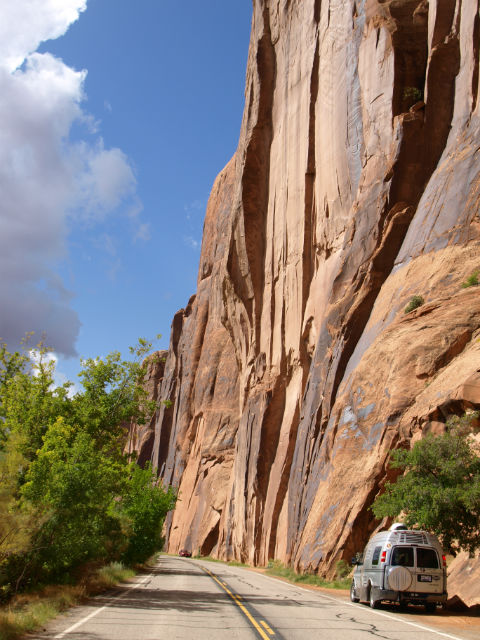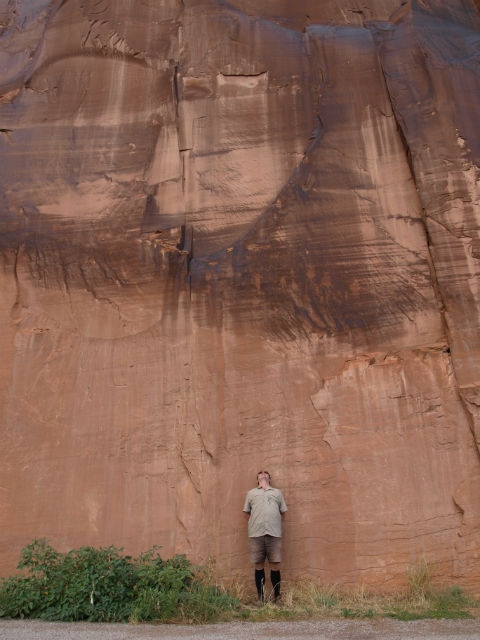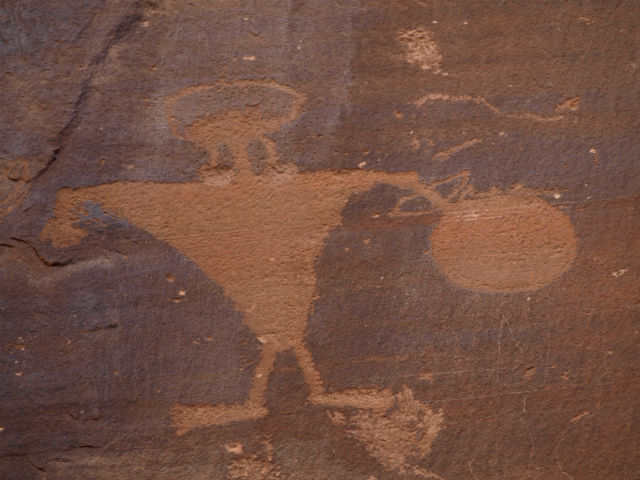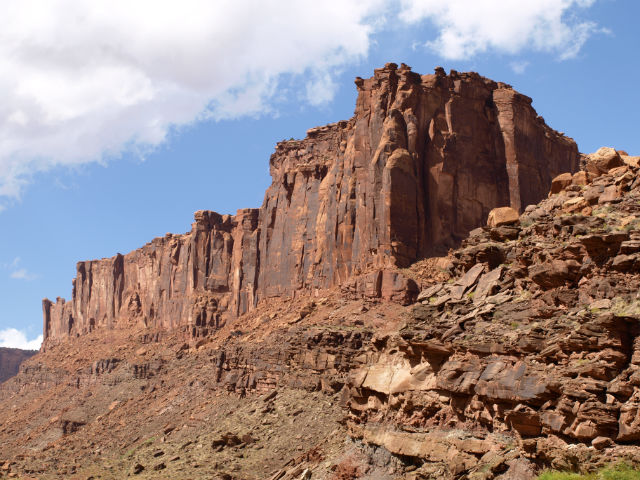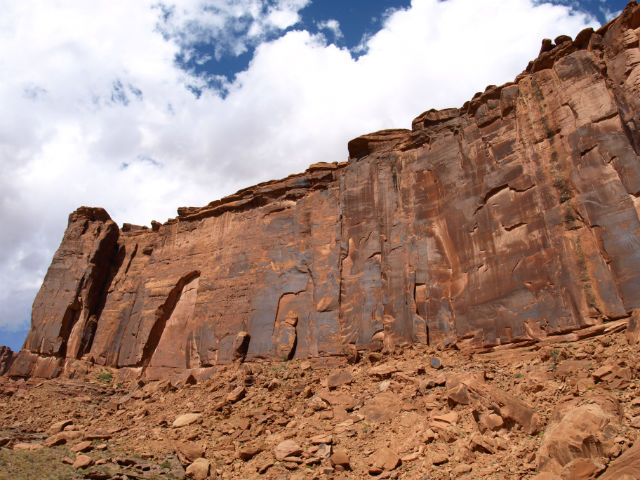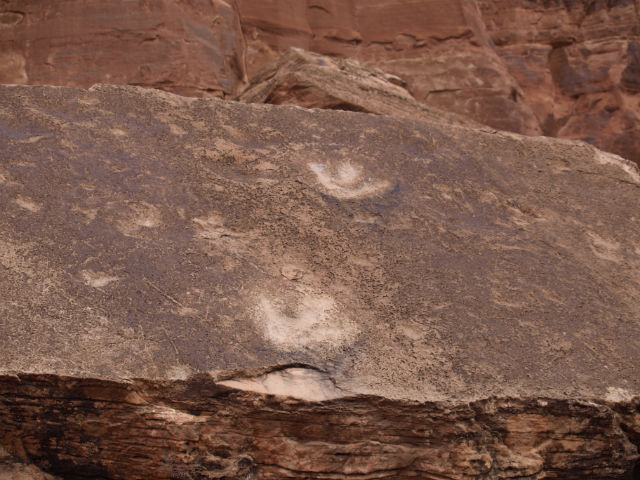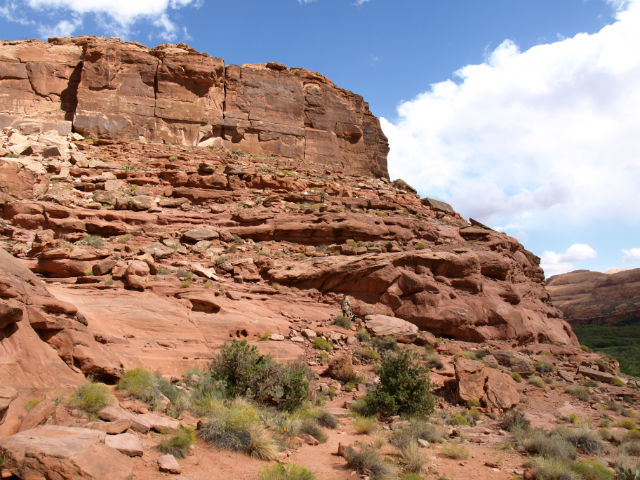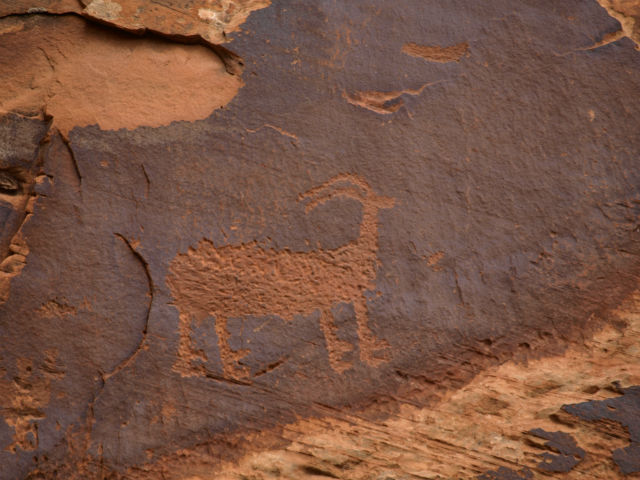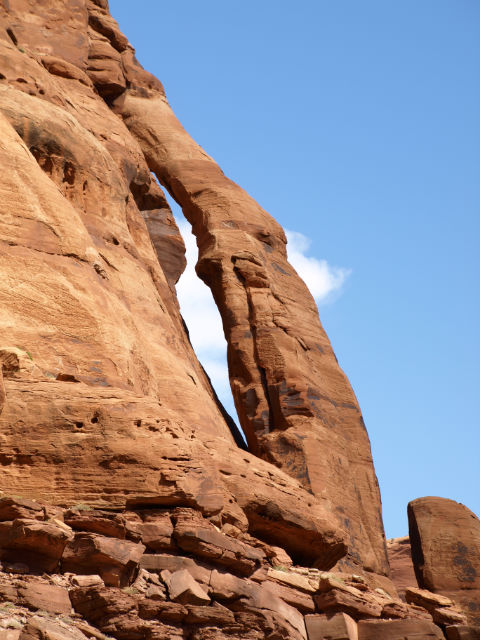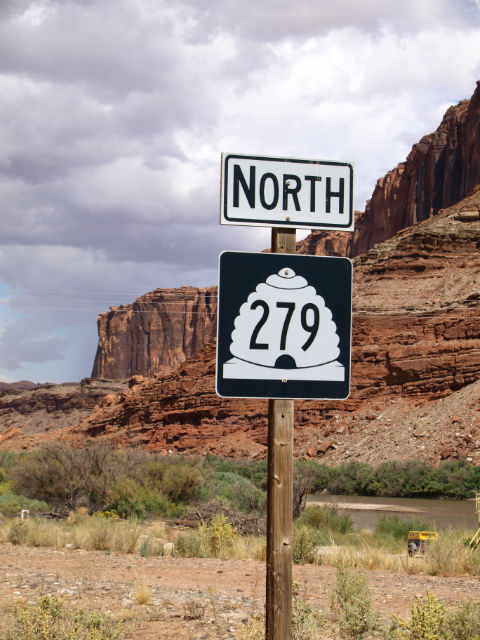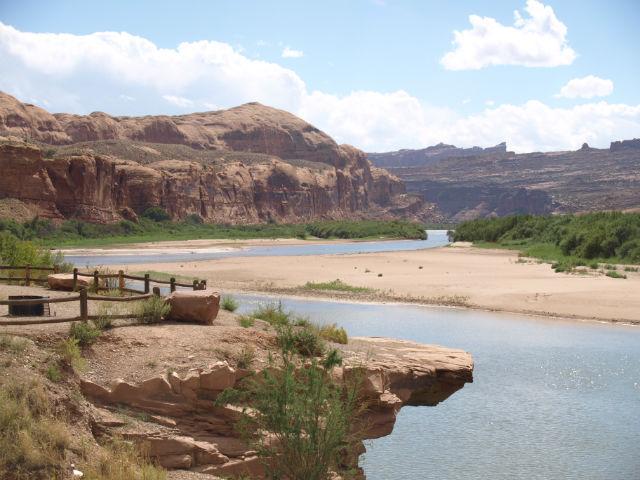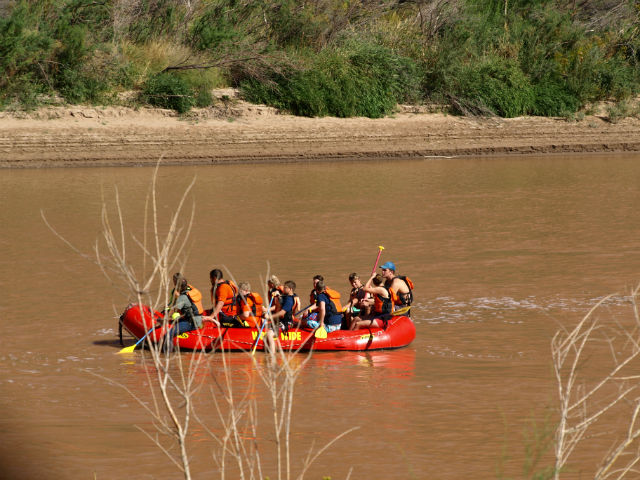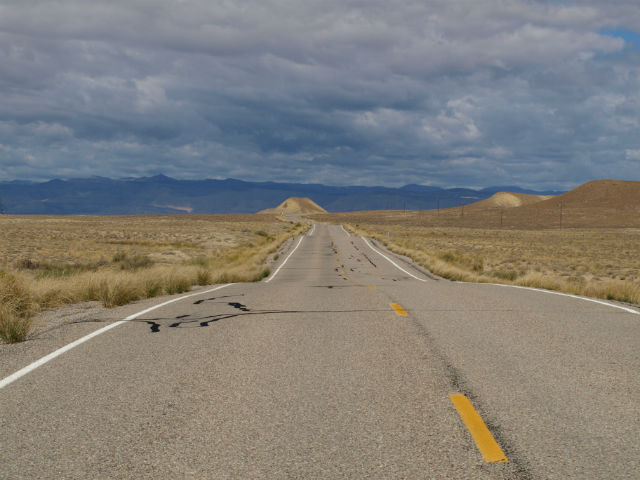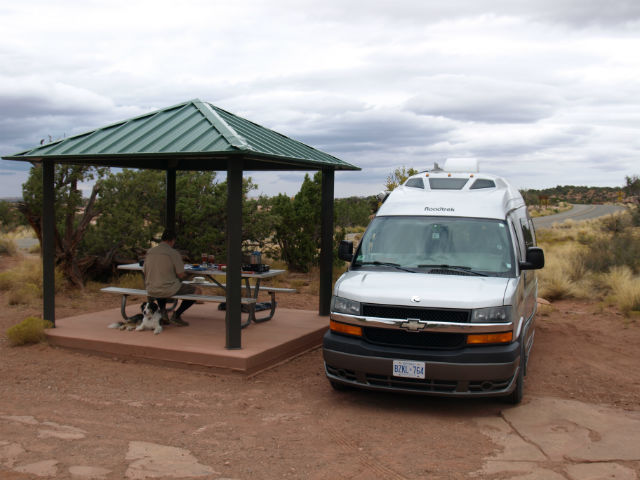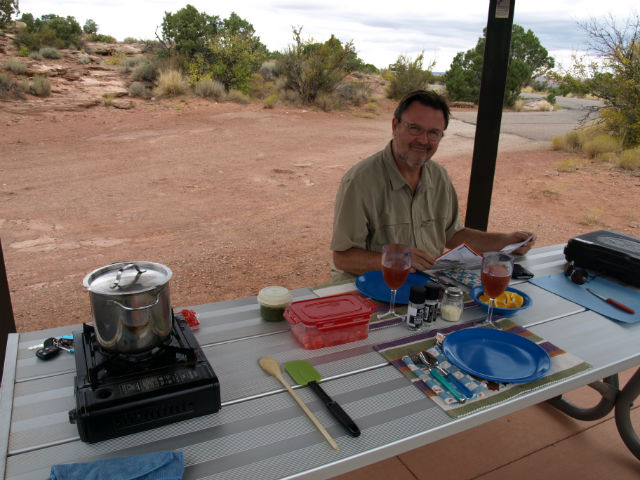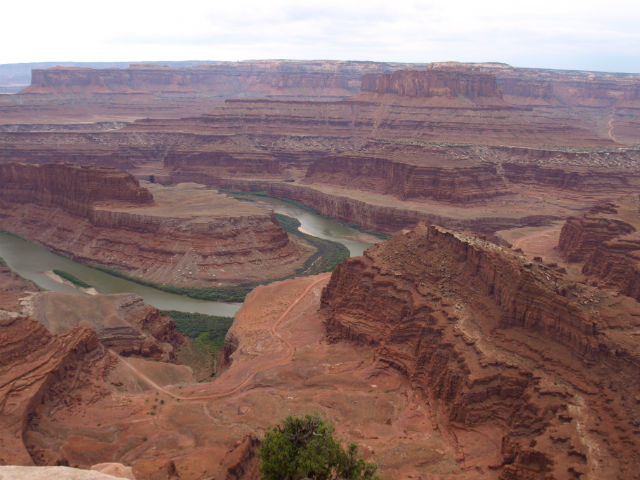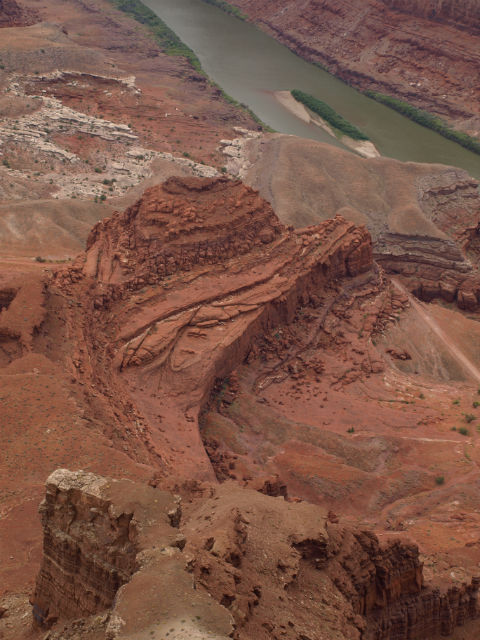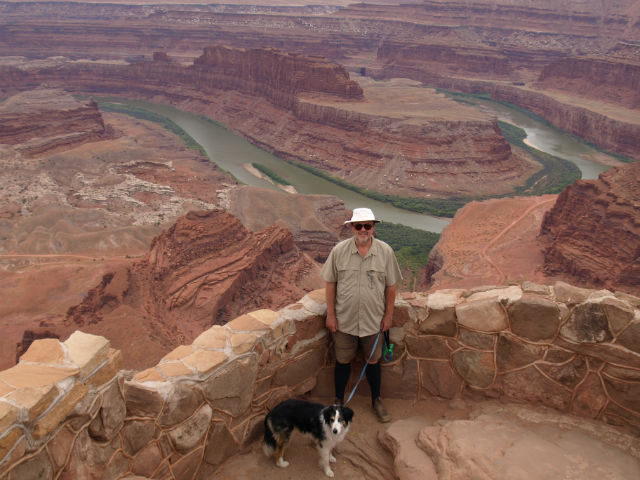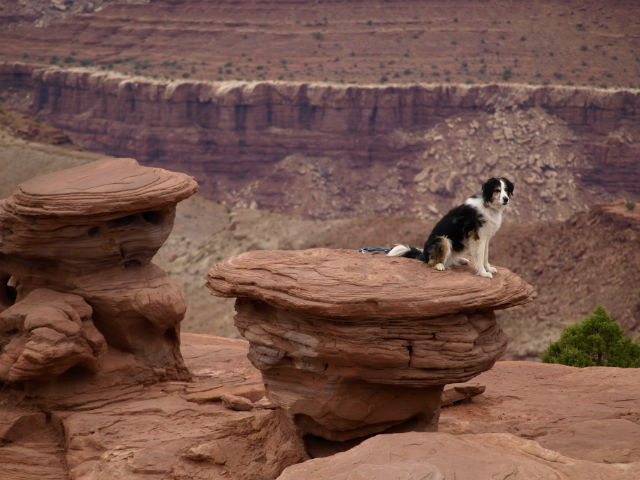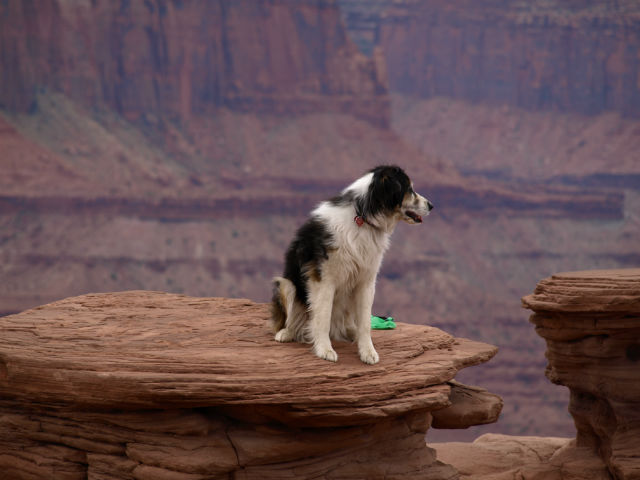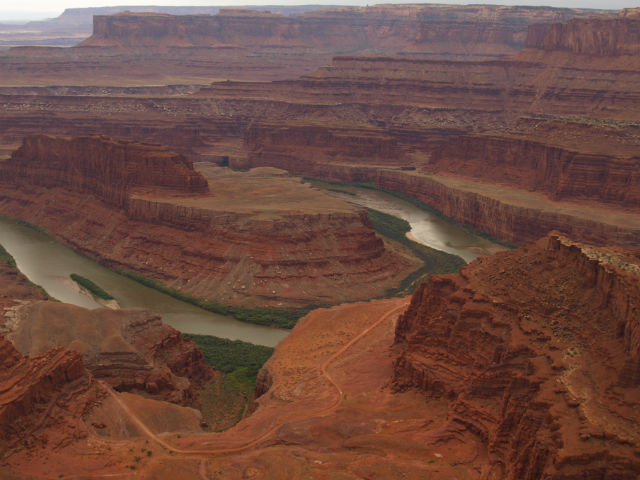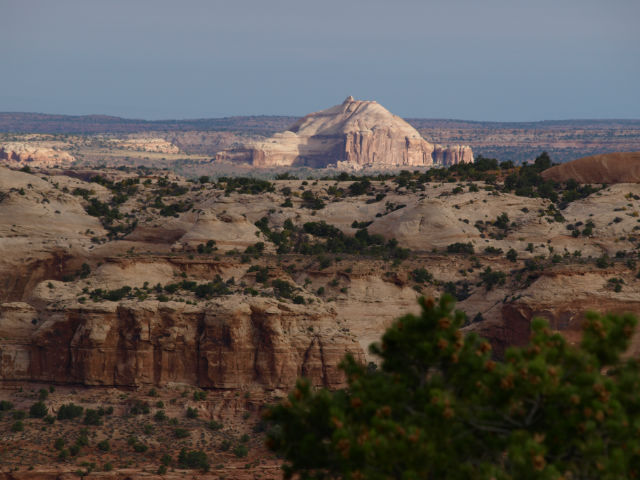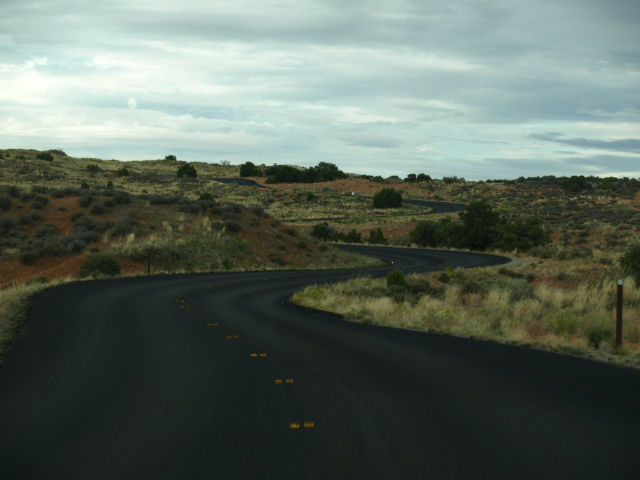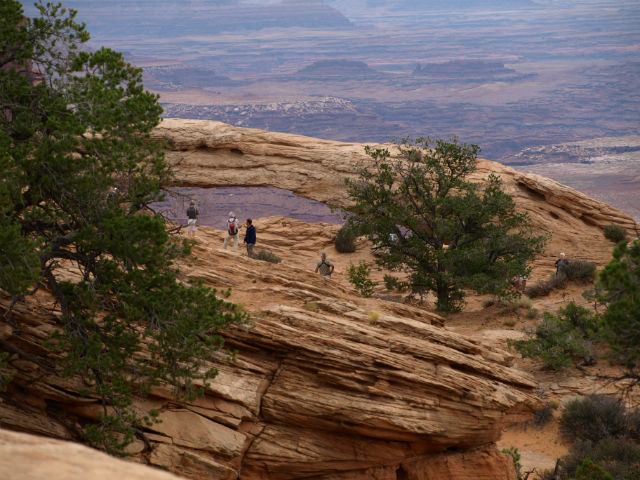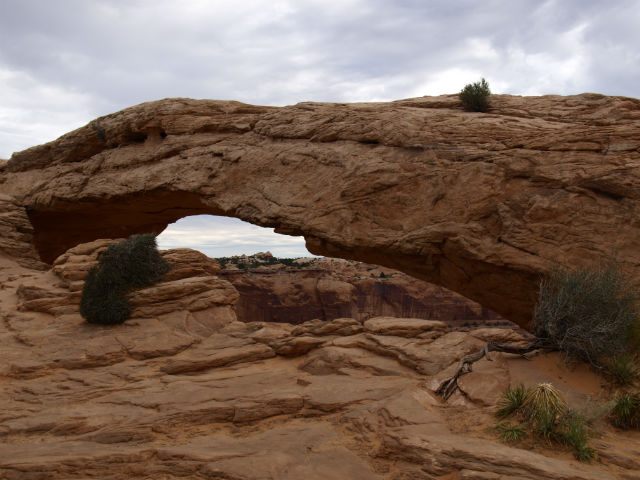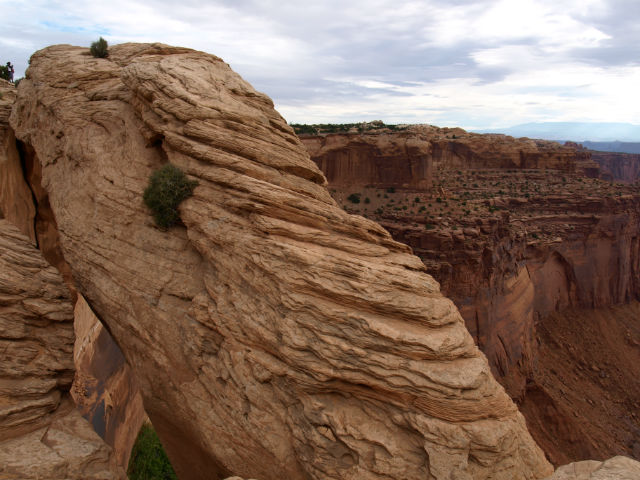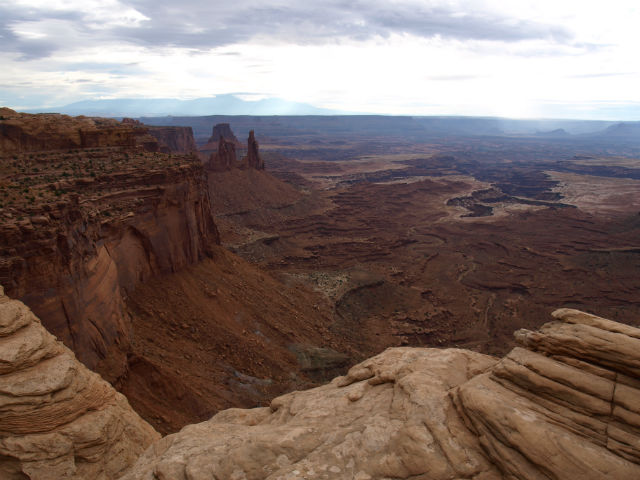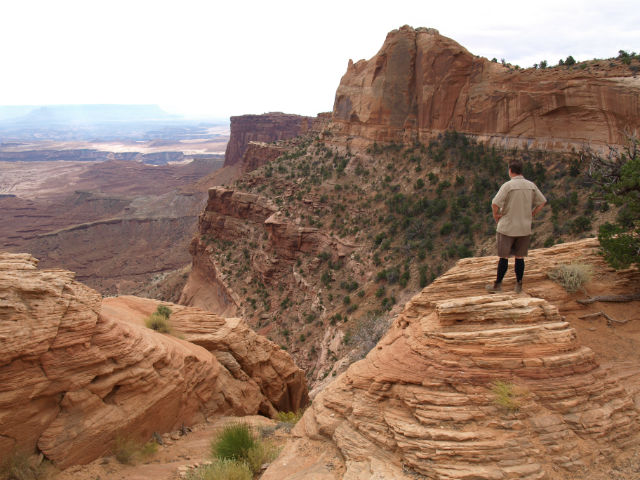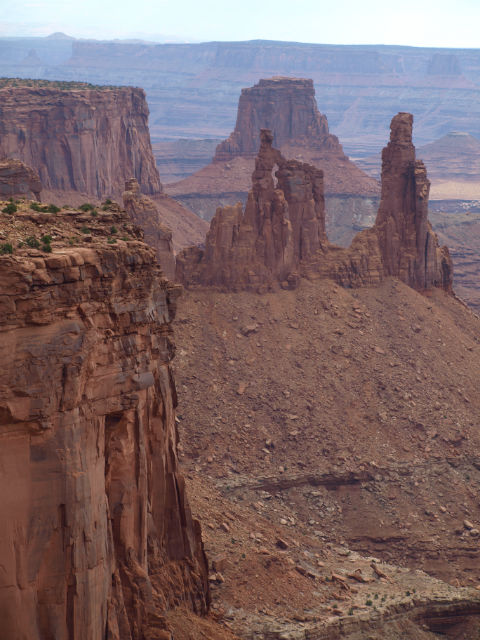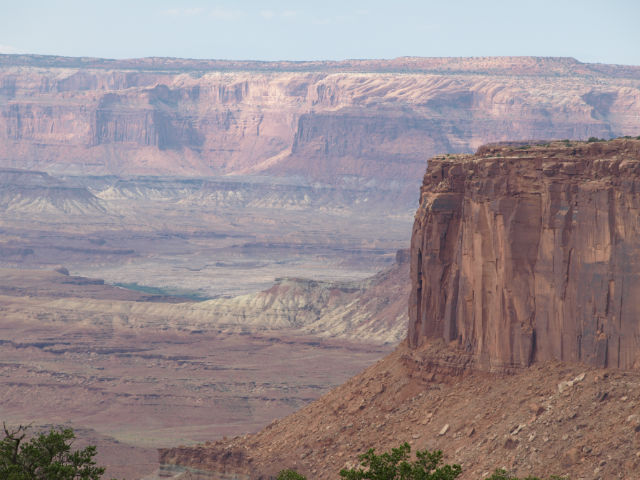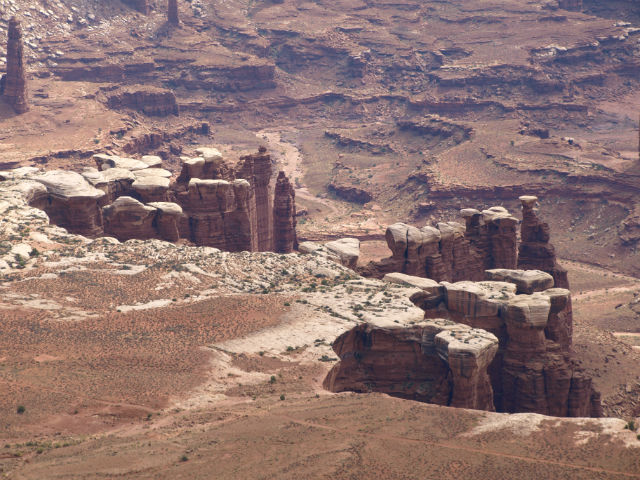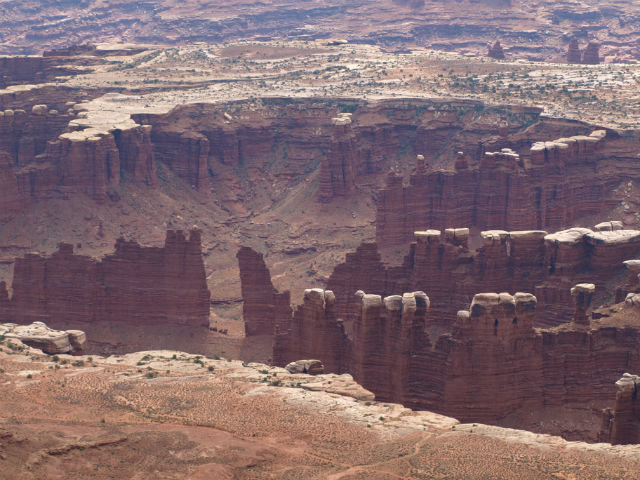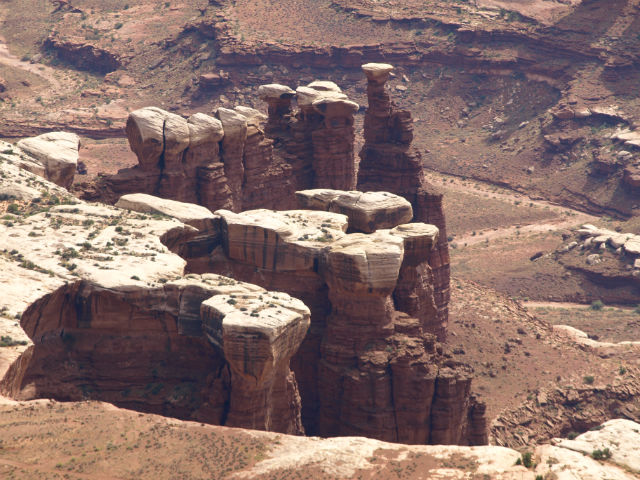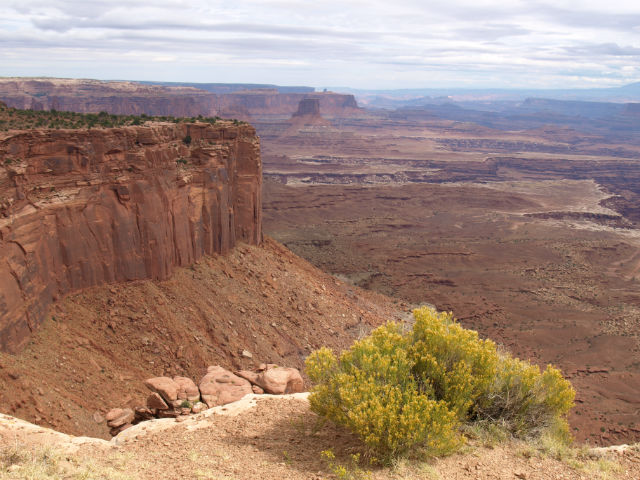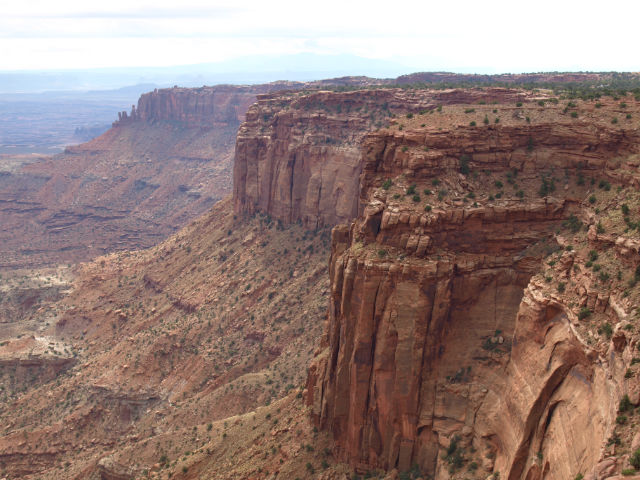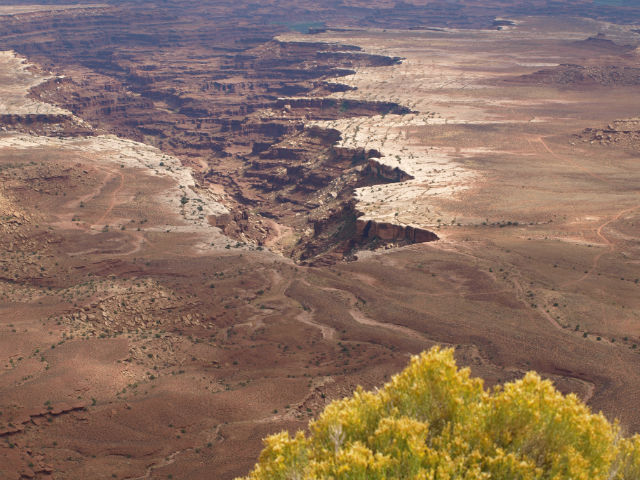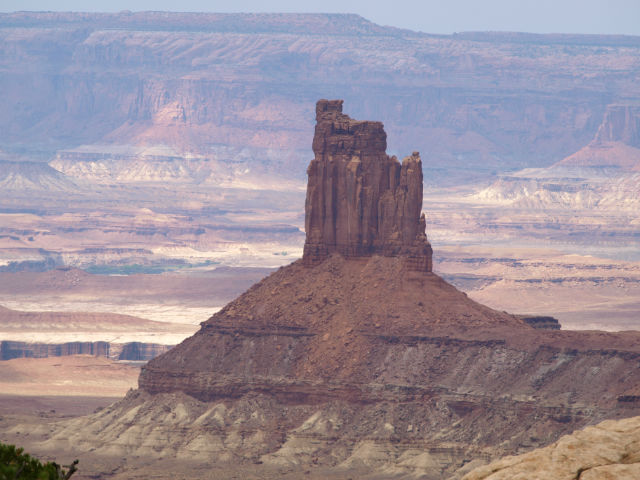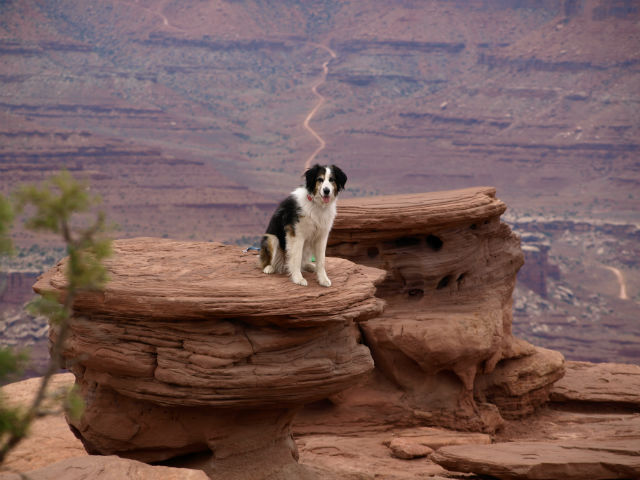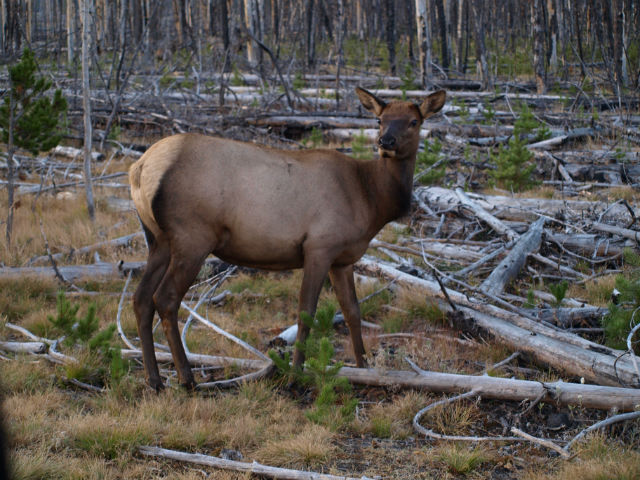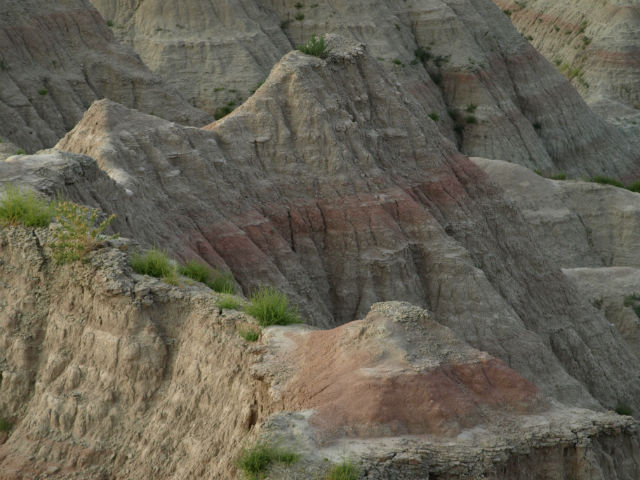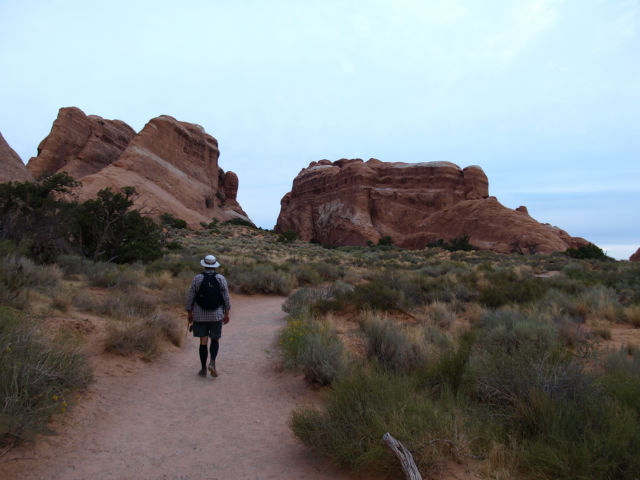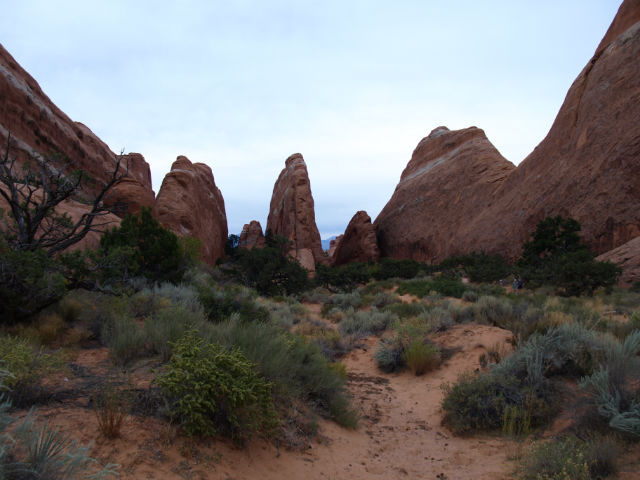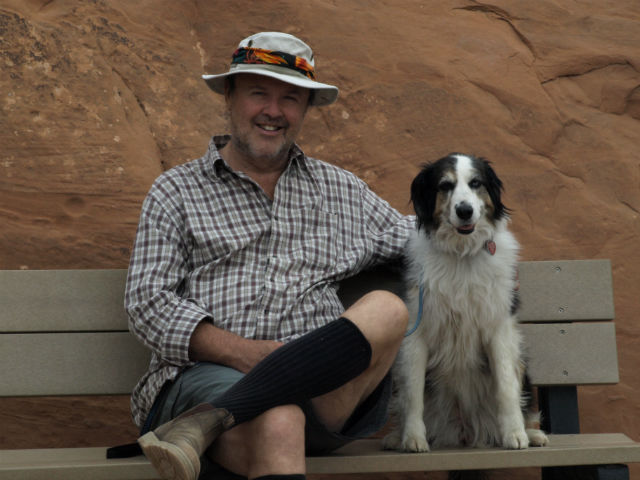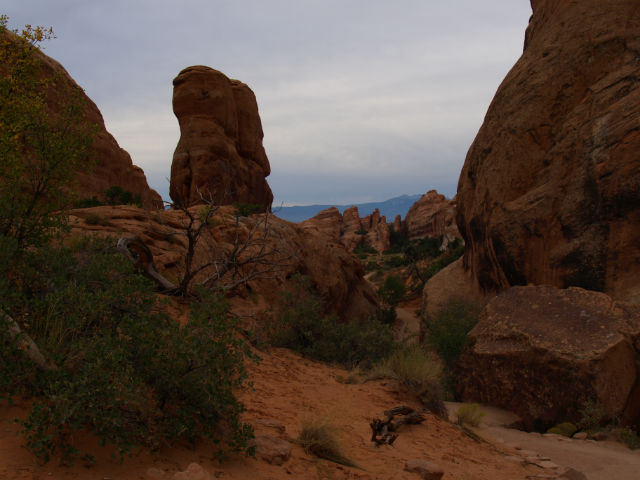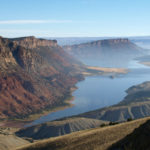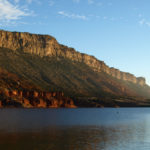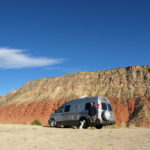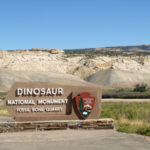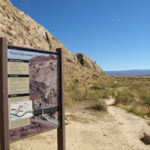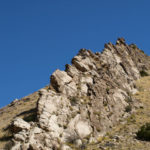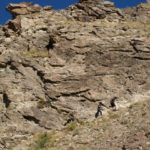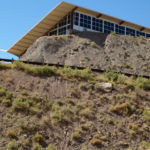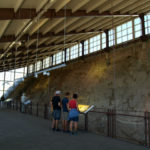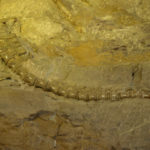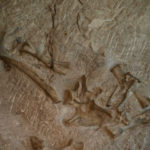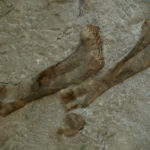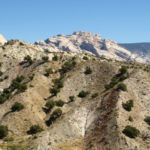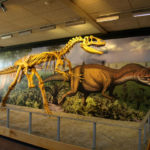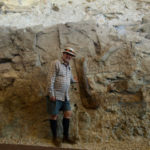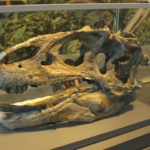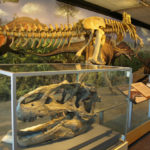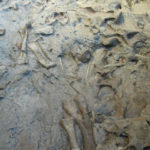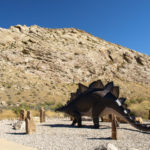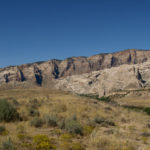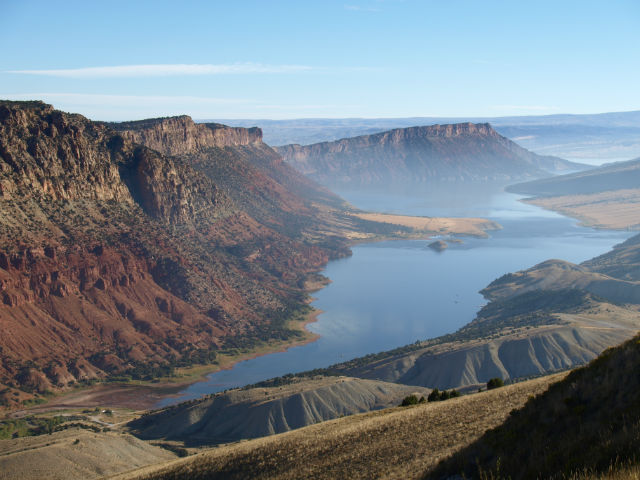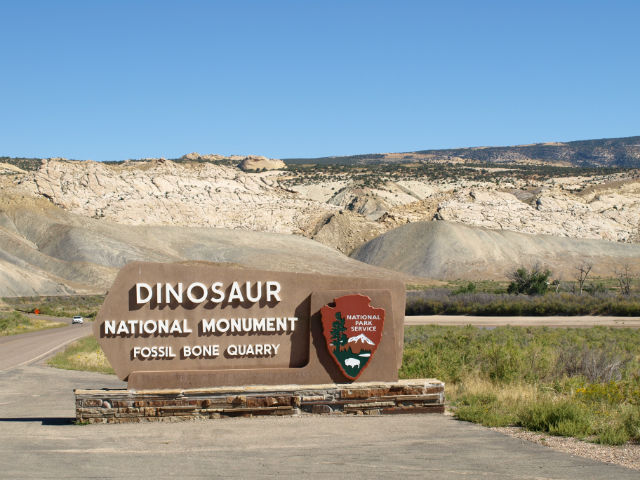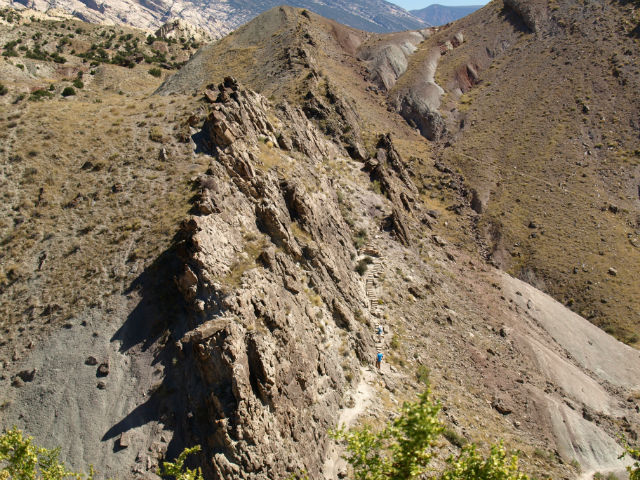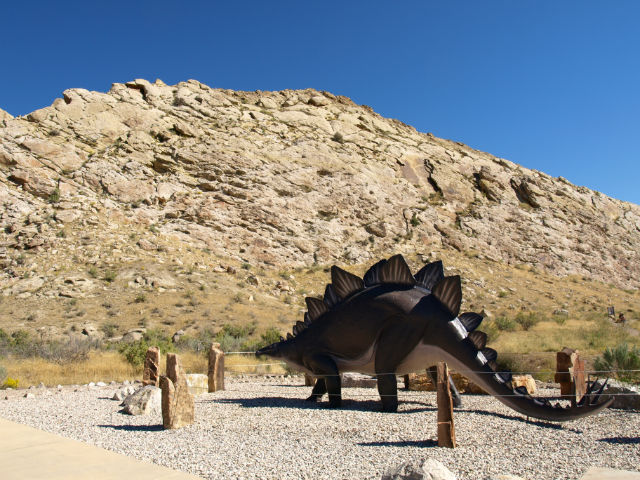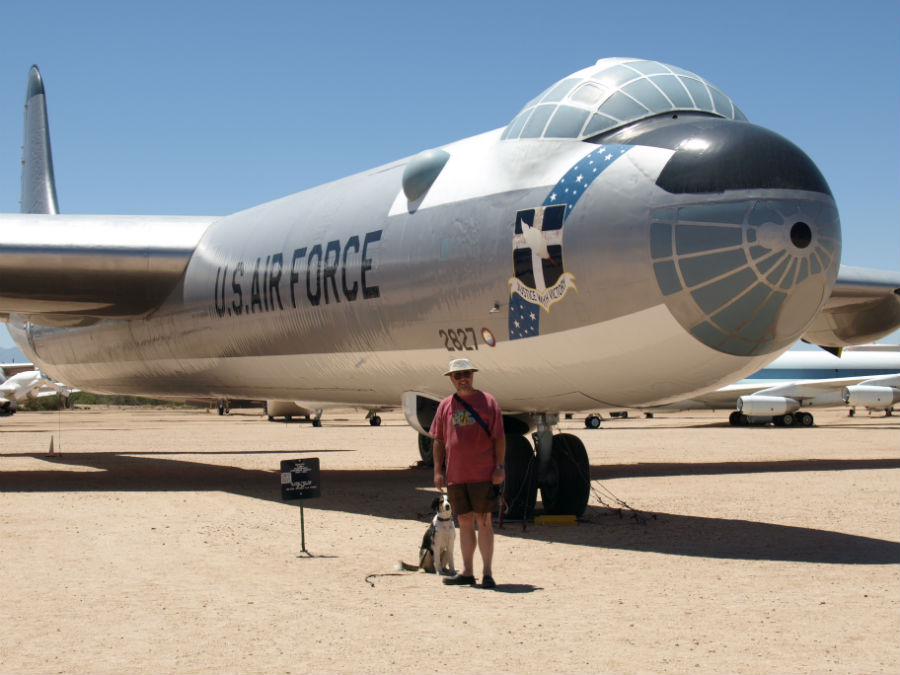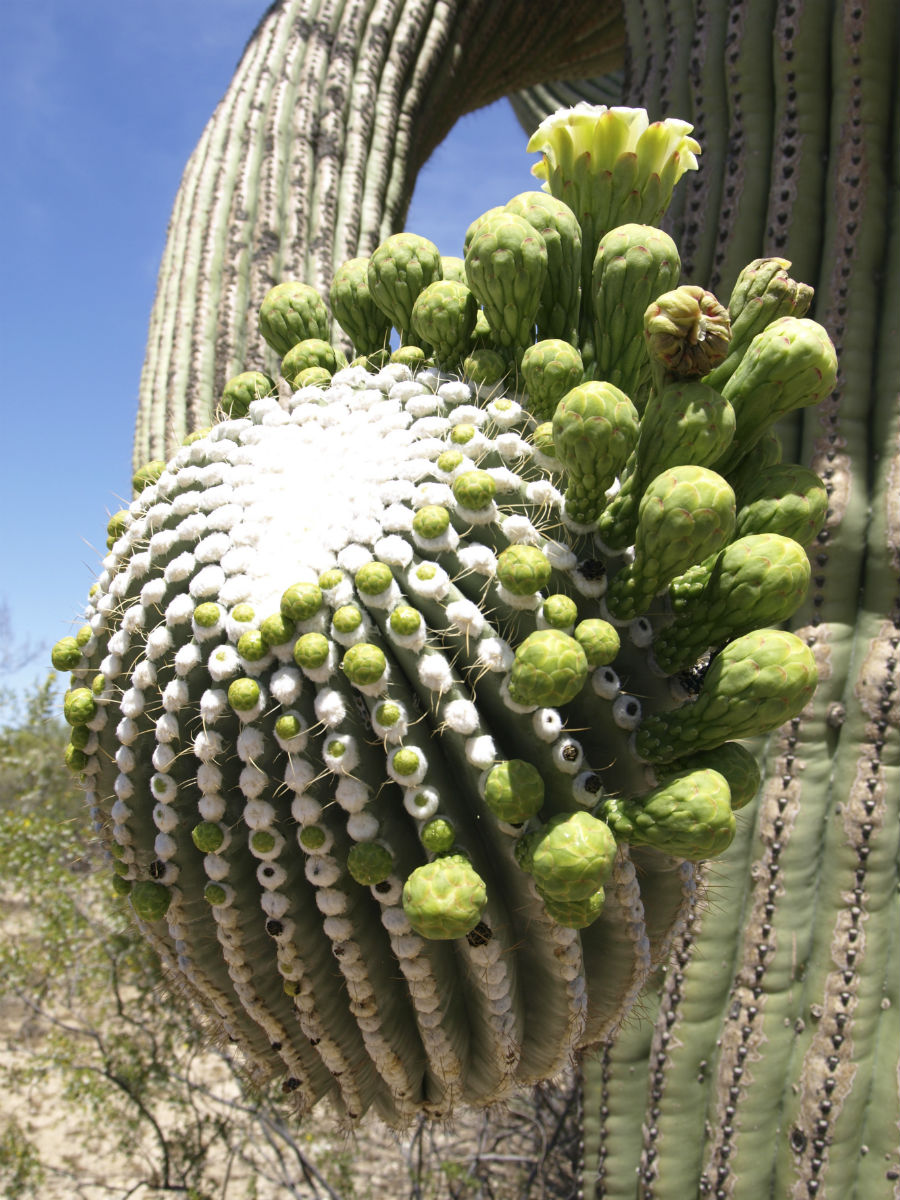Tag Archives: Utah
We found spots around Moab where there was … almost no one!
What really floors us about the area around Moab is how many visitors from out of state seem lasered on Arches National Park. We stopped a while at the Visitor Center along the I-70 interstate and listened in as one visitor after another asked only about Arches. We loved that particular park, but were just as enamoured with the other sites (some a bit more off the beaten path) that had no lineups, no crowds and, in some spots, almost no other people.
That’s how we spent this day. Exploring some of the lesser known routes and hiking trails.
We started with the road marked Scenic Byway 279, just 7km/4mi north of Moab. The narrow road is paved and snakes beside the Colorado River. It’s a one-way trip (at least for a camper van) and is miles of astounding scenery and scenic pullovers until it turns into a rougher dirt road that heads deep into the floor of the canyon. On our wish list for next time: a 4WD tour past this point.
Right from the start, we were treated to soaring red rock cliffs on our right hand side, a favourite spot for rock climbers. They seemed to be the only other ones using this roadway.
There are pullouts along 279 to look at the Indian rock art and one great hike up to three-toed dinosaur tracks preserved in a flat slab of rock. It was a short climb up to get a very close look at the fossilized tracks. Amazing to see these and we wondered how many more fossilized remains must be caught in the miles and miles and layers of these remote red rock canyons.
We try to make sure we get out from the van and do a little hiking every day. We found the perfect spot at the pullout for Jug Handle Arch (another of the Moab area’s trademark arch formations). We had the place to ourselves, walked into the canyon, an area of Bighorn Sheep and cathedral-like red rocks that seem to vault up all around.
The next day we left Moab (and Utah) heading for Colorado and took the more backroads route, Scenic Byway 128 which also tracks the Colorado River, this time upstream. Highways 279 and 128 both follow the mighty river, and we saw many pretty BLM campgrounds, right on the riverbanks. These sites would be around $15USD/night, have few facilities, but the settings can’t be beat. They are on our list for the next time we are through.
It’s a great route for biking with a dedicated paved riding trail along a long stretch, rafting (also on our list for next time – can’t believe we missed it this time around!), birding and just a scenic drive. Heading east, the landscape changed dramatically (which has made route 279 a favourite for movie shoot locations): from the tall red cliffs that are the backside of Arches National Park, to spires, buttes and pinnacles, to rubble-like moraine to wide open high plains. We drove past the abandoned community of Cisco, which was once part of a robust mining economy and later a film site for Thelma & Louise.
Sad to say goodbye to Utah. Excited about exploring Colorado.
We’ve posted all sorts of photos here.
Canyonlands & Dead Horse — Photos
Rocks are so much more interesting than Brangelina!
This part of Utah – here at Utah’s Canyonlands – is what writer and environmentalist Edward Abbey called the “most arid, most hostile, most lonesome, most grim, bleak, barren, desolate and savage quarter of the state of Utah – the best part by far.”
It was another early alarm clock day as we set off for both Canyonlands National Park and neighbouring Dead Horse State Park, about a 35-minute drive from our campground in Moab. We wanted to beat any crowds and be there as close to sunrise as possible.
We pulled into the park before the Visitor Center was even open, so set up and cooked breakfast. We love this about the Roadtrek – we can cook, eat, clean up (and take short naps) ANYWHERE. The flexibility of the lifestyle is irresistible.
After brekkie, we watched the excellent short film at the Canyonlands Visitor Center, just to get an idea of what was ahead. We’ve been finding that the park intro films give us just the right amount of background about geology, wildlife, etc. to really help us appreciate our visit.
While the roads and trails at Arches National Park wove between dramatic red rock formations, Canyonlands is more about never-ending vistas and the expansive canyons in this part of the Colorado Plateau. Millions of years ago, this was an area of shallow seas, sedimentation, and uplift forming the current landscape when great blocks of rock fractured and were eroded into needles, spires and arches.
We were at one of the highlights – Mesa Arch – well before the crowds got there. That being said, Canyonlands has many fewer visitors than Arches, so there was nothing like a lineup of cars at the entry gates. In the final tally, it’s the remoteness of today’s two parks that would make them our top picks in the area.
We drove all the scenic drives, got out and took hundreds of photos, did a few hikes (the short Mesa Arch loop trail and the trail at Upheaval Dome as well as rim trails at most of the lookouts). The national parks are not particularly dog friendly – dogs are only allowed in parking lots and certain paved areas, so our hiking time was pretty limited.
From the pullouts and trails we could see the great, wide river canyons and the meandering, wide green water of the Colorado River. Canyonlands is the confluence of the Green River and the Colorado River. The area was largely unmapped until the expeditions of John Wesley Powell in the 1860s – the same explorer who mapped Grand Canyon.
We found ourselves comparing Canyonlands to Grand Canyon. In some ways, Canyonlands seems more “relatable”: They are similar in geology, but the canyons here are much wider and more expansive (not as deep though). Next time we come here we’ll put aside a full fay to take one of the jeep tours along the very bottom of the canyons – we could see a few at a distance, navigating the dirt roads. Seeing the canyons from the “bottom up” would be very cool.
Not far down the road from Canyonlands, we stopped at Dead Horse State Park. The view from the overlook at Dead Horse Point – of the gooseneck turn in the Colorado River – is on almost every Utah Tourism brochure. It’s also close to the spot where Thelma and Louise took that famous last ride over the cliff edge.
Dead Horse is like a long peninsula rising above the canyon far below. It’s said that in the late 1800s, cowboys would herd wild mustangs to Dead Horse Point, then lay brush and branches across the narrowest point called the Neck, essentially creating a natural corral.
The sun was setting and we decided we wanted to spend the night in this beautiful, remote spot. The park campgrounds were full, but we tried a dirt side road and found a very nice, small BLM site called Horsethief just north of the state park. Our hope was that the skies would clear and we’d be able to appreciate the pitch black and why Dead Horse and Canyonlands have both been designated as International Dark Sky Parks. Not so lucky . . . soon after we pulled in a light rain started to fall. No stars, but the high desert after a light rain smells so very special. Clean, renewed with hints of pinyon-pine and juniper.
Edward Abbey’s book, Desert Solitaire, is an environmentalist’s classic – a great read. It’s on our bookshelf at home but, oddly enough, the public library in Kingston doesn’t have it in its collection. Ditto for his other well-known book, The Monkey Wrench Gang. They both deserve much more ink and spotlight than the current Brangelina meltdown!
Wacky questions Park Rangers hear . . .
We couldn’t make these up.
At each park we’ve chatted with the wonderful park rangers, asking them what kinds of strange questions they hear. They’ve been very diplomatic with their answers to us, but also had some real gems to share. Honestly, for some of them it’s hard to know what to say! Kind of reminds us of a bumper sticker we once saw: Go outside. the graphics are amazing!
Almost every single western park: When do the mule deer turn into elk?
Dead Horse State Park, Utah: Can you see the Pacific Ocean from here?
Canyonlands National Park, Utah (at the canyon rim): Is that a green screen behind you?
Badlands National Park, South Dakota: Who paints the rocks?
Arches National Park, Utah: How long did all this take to build?
Dinosaur National Monument: Why aren’t you a Young Earth creationist?
Photos: On the trail by sunrise at Arches National Park
The rocks are gonna fall … someday.
The geology at Arches National Park in Utah is dizzying. (Even for someone with a geology background.)
But here’s what you really need to know: this is one popular park and it can become crowded. Tour buses. Gargantuan RVs. The whole nine yards. (We saw an RV with a bumper sticker that said: Does my RV make me look fat?). By 8:30am the cars and RVs are lined up at the entry. So, we set our alarm for 6am, were inside the park a half-hour later and on the Devils Garden Trailhead by 7am, just in time for sunrise.
We (almost) had the trail to ourselves – and after a fantastic 2.5-hour hike, on the way back we met throngs of people just starting. Climbing up was not so bad. Getting down was a seat-of-the-pants affair. So glad we got there early, hiked before it became too warm and could enjoy the quiet of the red sandstone formations.
Seriously though, the geology here gets complicated. (The Visitor Center has a very good movie that explains it all in a whirl.) A massive inland sea that filled and evaporated, filled and evaporated. All the while salt deposits are building up. Sediments were deposited on top of the rock, the layers buckled and the rock layers were thrust upwards creating domes which weathered over time to create the arches, pinnacles, red rock canyons and balanced rocks. This process took, oh … 300 million years.
An Arches cheat sheet:
- There are more than 2,000 arches in the park.
- Arches are a rarity in nature’s architecture.
- The arches were shaped by water.
- Given enough time, all arches eventually collapse.
- The rocks at Arches National Park are sedimentary.
- Get through the entry booth a half-hour before sunrise. Seriously.
Got dinos? Photos from Dinosaur National Park
Craig gets to play with dinosaurs
First, we overnighted near Flaming Gorge, UT and were the only ones at a National Forest desert campsite. This is what we woke up to in the morning . . .
Crossing from Wyoming into Utah we seemed to bump up against two themes: Mormons (on the radio and on display at the large and frequent temples) and dinosaurs. Yes, this is dino country and that was a blast back to Craig’s little boy years when he was (by his own admission): Dinosaur Crazy.
Dinosaur National Monument wasn’t on our original itinerary but we have this thing about tossing the map out the window and changing course. A little out of the way, but well worth the detour.
Dinosaur National Monument straddles the border of Utah and Colorado – we were visiting the park from the Utah side. It’s in a remote corner of the state; high desert with rugged rock formations, wild river canyons and mile-long vistas. It’s the only NPS park established to protect exact dinosaur remains.
The most famous geologic formation is the Morrison Formation, a virtual bounty of dinosaur fossils. Much of it is captured at the dramatic Quarry Exhibit Hall, an enclosed rock wall of an original dig that is one of the best places in the world to see and touch actual dinosaur bones in place. What a great idea – they found a huge cache of fossils and bones and built the exhibit around it.
Craig drove Rigby and the van up the hillside to the exhibit building and Jo hiked the 1.2-km Fossil Discovery Trail (note to self: next time remember the hat and water).
Why so many fossils in one place? The park ranger explained that this area was once part of an ancient river that flowed across a vast plain. A long drought killed off many of the dinosaurs and creatures, followed by extensive rains that washed their bones along the river bottom, creating what he called a dinosaur bone “logjam.” Many of the bones were concentrated at the oxbow bend in the river. Over time, sedimentary mud and rock covered the bones, fossilizing them in place.
In addition to the fossil-rich rocks and world-class dinosaur exhibits, the national monument is a geologist’s dream destination. Twenty-three layers of folded, tilted, faulted and eroded rock layers preserve ecosystems spanning 1.2 billion years. We drove the Cub Creek and Split Mountain Drives, stopping often to focus the camera and get some shots.
We’ve also created a separate photos-only post from Dinosaur National Monument. Before you go there, consider these facts:
- 65 million years ago: all dinosaurs go extinct.
- The Royal Ontario Museum in Toronto, Canada (ROM) has a Barosaurus skeleton excavated from an early dig at Dinosaur National Monument.
- The quarry site represents fossils collected from 400 different dinosaurs.
- The park is one of the best windows into the era of Upper Jurassic era dinosaurs.
- Craig was one happy camper. He got to play with dinosaurs all day!
Dog-friendly destinations
Rigby is an easy-travellin’ kind of dog, so we have it made. In fact, she opens doors and brings down barriers with everyone she meets. We’re often astounded at how many dog positive people we encounter – at campgrounds, along city sidewalks, in shops, museums and at parks. We’ve got some general tips of how to source out pet-friendly stays, a list of some of the exceptional dog-friendly destinations we’ve had the pleasure to visit and even a link to a unique dog service in Canada to help if you can’t take Rover with you.
FINDING DOG-FRIENDLY STAYS
Destination websites often are great resources about the where-and-how of visiting with your pet.
Many towns, cities and parks welcome dogs and almost certainly have leash laws (usually a 2m/6ft leash). Off-leash parks may be the exception and a quick Internet check lists those golden spots for romp ’n’ run (kennel cough vaccination is a must-do if using these spaces).
Recognizing the trend for families and snowbirds to travel with pets in tow, many destinations are marketing themselves as dog friendly. In Florida, Panama City Beach boasts two beaches where owners can splash in the waves with their leashed pets. A Pensacola dog park includes a fenced dog beach where off-leash pooches can swim and cool off in the water. In Knoxville, TN, dogs are allowed on dozens of restaurant patios as well as into the famous Blue Plate Special noontime concert series at the city’s visitor centre. The International UFO Museum in Roswell, NM and the Pima Air & Space Museum in Tucson open their doors to well-behaved dogs on leash.
When it comes to hotel and motel stays, it’s always best to call ahead: some hotels forbid pets, others allow well-behaved pets that are not left unaccompanied and additional charges vary (from outrageous amounts exceeding the base room rate to reasonable fees to cover cleaning). Set a good example: no dogs on the furniture, regular trips to use the outdoor facilities and definitely no barking.
Policies vary at campgrounds as well. While most accept pets (leash regulations apply) it’s best to check in advance. In Ontario, all 30 provincial parks have designated exercise areas and some keep things separate with pet-free campground loops. Check out the Ontario Parks blog posting that details stays with your dog. Each campground website should let you know the do’s and don’ts.
LOOKING FOR DOG CARE?
While we haven’t had to use this service, we’ve heard that in Canada and the U.S. you can find a pre-screened, insured dog sitter who provides a cage-free environment through DogVacay. Rates include pet insurance and a daily photo, so you can stay updated. Can’t vouch for the service but we’d love to hear from those who have!
OUR FAVOURITE “DOG-POSITIVE” STOPS
We are always on the hunt for attractions, parks, etc. where we can include Rigby in our explorations. We know we’ve barely scratched the surface of what’s out there, but here are some of our favourites and a few photos to get you thinking of what’s possible:
McGee’s Atchafalaya Basin Swamp Tours, Louisiana
Why we love it: Getting out on a pontoon boat tour is the best way to really understand the Atchafalaya Basin, America’s largest freshwater swamp. The Basin flows between Lafayette and Baton Rouge and its nature-rich waters are largely inaccessible by car. So, boat is the way and McGee’s welcomed Rigby aboard. With gators in the water we were especially vigilant.
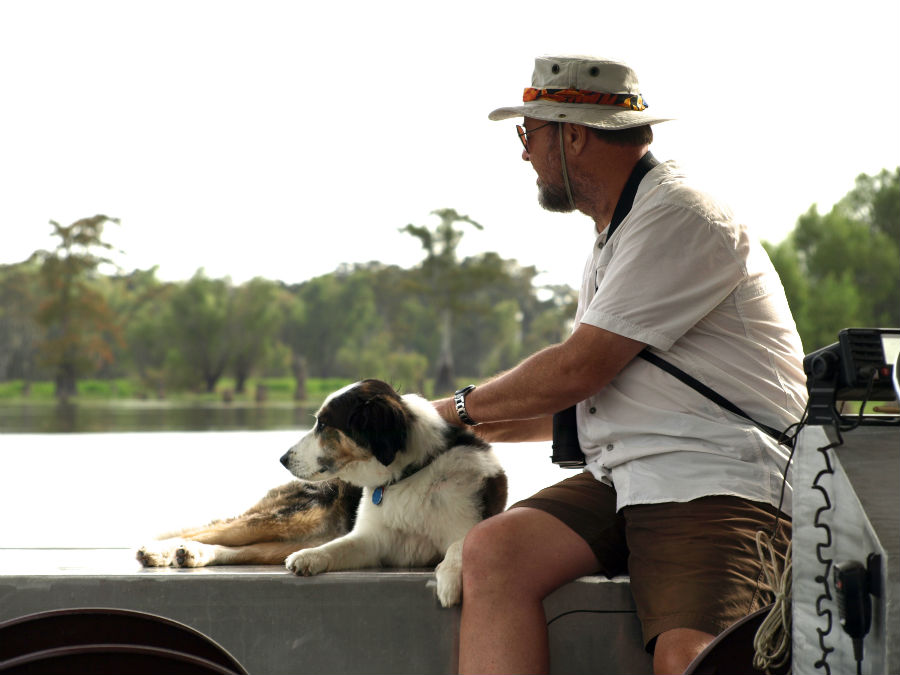
International UFO Museum, New Mexico
Why we love it: It can get pretty steamy in southern New Mexico and rather than have dogs left in overheated vehicles, the UFO Museum in quirky Roswell welcomes them into the facility. Rigby was oblivious to the displays of alien sightings and lifeforms but we thought it was pretty cool (even if improbable).
Pima Air & Space Museum, Arizona
Why we love it: One of the world’s largest aerospace museums is on the edge of urban Tucson. Dogs are welcome in both the indoor hangars and the acres and acres of hundreds of aircraft on display outdoors. Walking the grounds covers the entire history of flight from Kitty Hawk to supersonic across 80 acres of American aviation technology. From propeller-driven to jet engine fighters, cargo, reconnaissance, transport and bombers – if American aviation made it, it’s here.
Tubac Presidio State Historic Park, Arizona
Why we love it: We have a soft spot for historic destinations and the ruins (and partial reconstruction) of the original presidio (fort) at Tubac fit the bill. Dogs aren’t allowed in the museum or the buildings but it’s a nice hour-long walk around the grounds. The presidio was built in 1752, establishing Tubac as the oldest European settlement in Arizona.
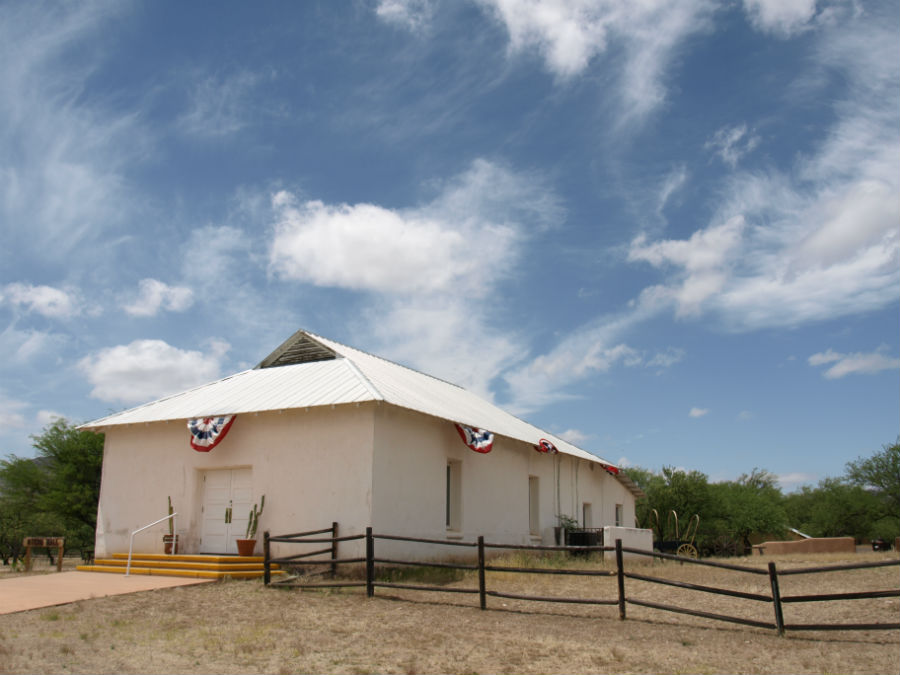
Tubac Golf Resort, Arizona
Why we love it: To say that Rigby was welcomed here would be an understatement. The golf course and bar are familiar to Kevin Costner fans – parts of Tin Cup were filmed here. Complementing the luxurious surroundings, when we checked into our villa there was a doggie welcome package complete with swag for Rigby. Outside, a spiderweb of trails for an on-leash walk.
Saguaro National Park, Arizona
Why we love it: Twenty types of snakes, 17 species of bats and dozens of varieties of prickly cacti are good reasons to keep your dog on leash. While dogs are not allowed on trails, they are allowed on roadways and in picnic areas (while leashed “with a human attached at the other end”). But the view from a walk along the roadways is still spectacular – forests of cacti, including some of the densest stands of the giant Saguaro cacti, the sentinel of the West only found in the Sonoran Desert. There are approximately 1.6 million Saguaro found in this park near Tucson.
San Pedro Riparian National Conservation Area, Arizona
Why we love it: Many prime birding sites don’t allow dogs, but San Pedro (just outside the snowbird haven of Sierra Vista) welcomes leashed dogs along the largely level trails that wind along a river lined with giant cottonwood groves. Oh yeah, there are birds too. And lots of them – the NCA is a designated Globally Important Bird Area, with more than 100 species of breeding birds and another 250 species of migrant and wintering birds. We shared the trail with binocular-toting birders from around the world who were also enthusiastic dog lovers.
A Taste of Old Town Scottsdale, Arizona
Why we love it: It’s a match made in heaven (consume the calories and then immediately burn them off while walking the dog on this downtown Scottsdale food tour). Most of the time Rigby needed to wait outside the eateries (although some with patios did welcome dogs) but moving from place-to-place was a great way to explore the Old Town district.
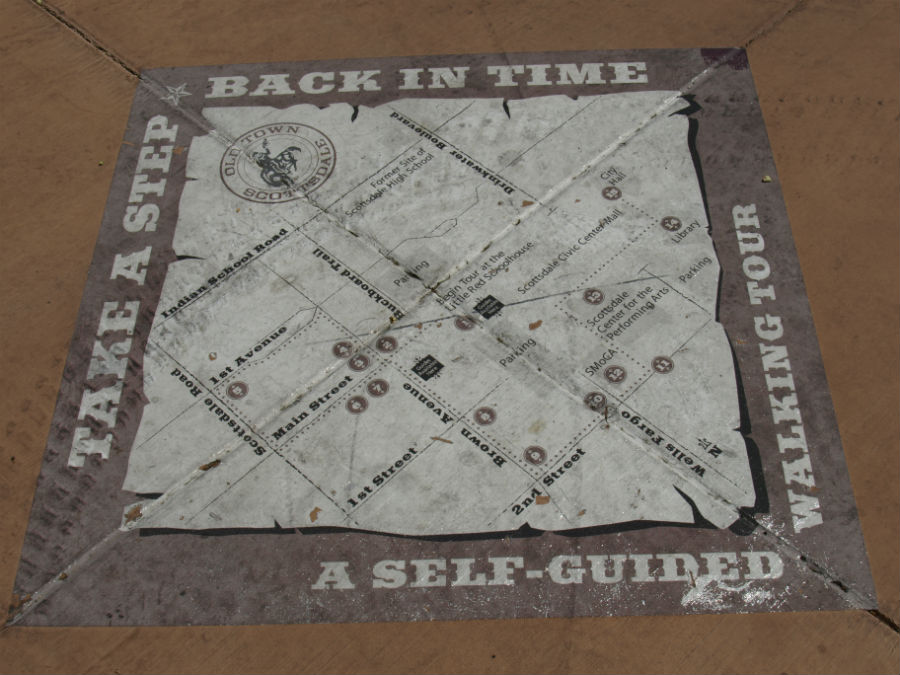
Veterans Oasis Park and Gilbert Riparian Preserve at Water Ranch, Arizona
Why we love it: The sprawling Phoenix metropolitan area is actually sprinkled with fantastic, natural parks tucked into urban settings. Our two favourites (dog friendly, on leash) were the Gilbert Riparian Preserve, the place for birding with more than 200 species and Chandler’s lake-spotted Veterans Oasis Park. Both have miles of trails for walking through wetlands, riparian and desert settings, and lakes for fishing.
Moab Area Hiking Trails, Utah
Why we love it: Dogs are not permitted on the trails within nearby Arches National Park, but there are pet-friendly trails on much of the public lands that surround the park. While a leash is only recommended in the backcountry, dogs do need to be under verbal restraint and not chase or harass wildlife. We hiked Mary Jane Canyon, soaked our feet in the red mud of the stream and generally just gobbled up the delicious red rock scenery.
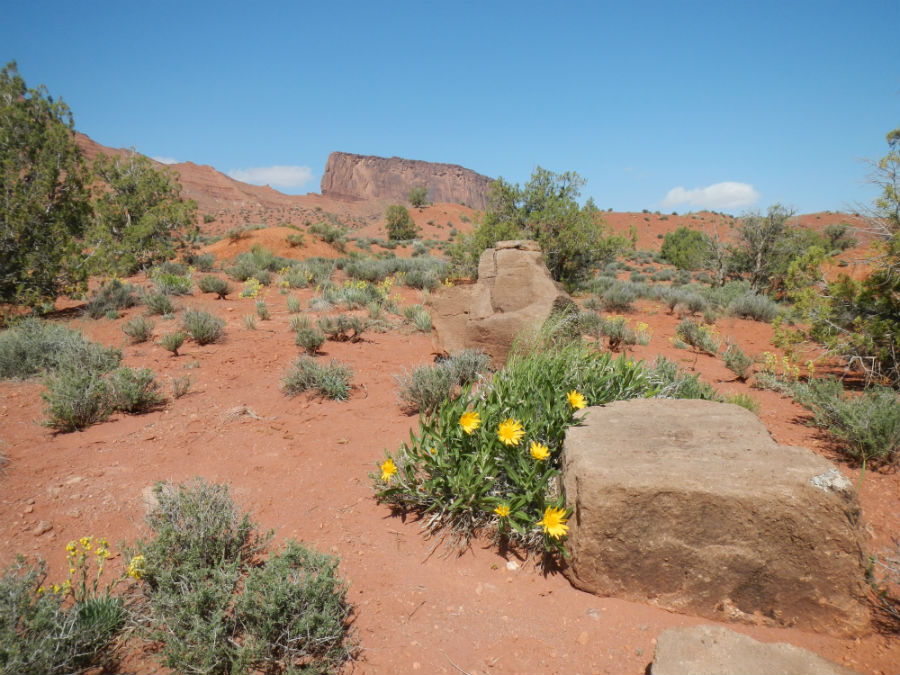
Self-guided city walking tours
Why we love them: Most visitor centres have self-guided walking tours of the city core. We check it out every time and can recommend any one of these:
Old Town Albuquerque where paw prints painted on the sidewalks lead from one pet-friendly shop to the next; the old copper mine in Bisbee, Arizona may be long closed, but the downtown has seen a remake of the old Brewery Gulch neighbourhood and the hilly shop-lined streets; Silver City near the Gila National Forest is know for its arts community, colourful murals and brightly-painted storefronts; strolling along one of the Natchez Trails above the banks of the Mississippi River through Bluff Park in the Southern town of Natchez; the historic streets of tiny Lincoln, New Mexico have been preserved as the Lincoln Historic Site, forever associated with the history of Billy the Kid, the charming gunslinger who became the iconic character of a wild and untamed territory; taking in the mural painted floodwalls in Paducah, Kentucky, a UNESCO Creative City and home to the National Quilt Museum; the whole easily-walkable town of blues-inspired Clarksdale, Mississippi is dog positive; Louisville, Kentucky is a large city with an extremely walkable downtown with a playful spirit. We checked out the enormous baseball bats outside the Louisville Slugger Museum, the giant golden David statue and the curvaceous exterior of the world-class Muhammad Ali Center.
